Our flight with Andrea W. from Siem Reap, Cambodia to Bangkok, Thailand was uneventful – for international flights, that’s a really good thing. Our Airbnb host had arranged for an airport transfer to their condo; the apartment had all the necessary conveniences – nothing too fancy, but comfortable. We quickly jumped into our arrivals routine: unpacked, explored the surrounding area and shopped for groceries. The neighbourhood had scarce services and conveniences, mostly fast food restaurants, a couple Starbucks, and a multitude of 7-Elevens – everything you would expect near a university.
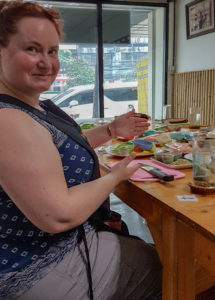 We had booked an early morning cooking class at the Bangkok Thai Cooking Academy for the next day. We met our instructor, Banks, at the Bang Chak BTS Skytrain station around 8:30AM. He led our group of ten eager ‘students’ through a local market, describing the different herbs and spices in Thai cuisine. We were not purchasing any of these ingredients, as this was a “choose your meal” class, with each student pre-selecting a soup or salad, an appetizer, a curry, a stir fry and a dessert.
We had booked an early morning cooking class at the Bangkok Thai Cooking Academy for the next day. We met our instructor, Banks, at the Bang Chak BTS Skytrain station around 8:30AM. He led our group of ten eager ‘students’ through a local market, describing the different herbs and spices in Thai cuisine. We were not purchasing any of these ingredients, as this was a “choose your meal” class, with each student pre-selecting a soup or salad, an appetizer, a curry, a stir fry and a dessert.  The ingredients were waiting for us back at the school: a red curry for Andrea, Panang for Dave and Massaman for Gilles. With ten individuals creating their own menu, the class could have easily turned into CHAOS – a word used many times by Banks. However, staff members were well prepared and Banks coordinated, instructed and supervised with ease, even injecting some humour in the day. We left our cooking class, having prepared and ingested five courses, bellies full and smiles on our faces. Our day, however, was not over. We boarded the BTS Skytrain for another destination: Jim Thompson House, the former home, turned museum, of the American businessman, architect and founder of the Thai Silk Company. An assigned guide led our small group through the individual buildings and gardens, explaining the design, the artifacts and the daily life of Jim Thompson. In late afternoon, Gilles and Andrea headed back to the condo for some rest and relaxation while Dave tracked down an electronics mall. Much walking (and sweating later) he returned home without the camera equipment he was hoping to buy.
The ingredients were waiting for us back at the school: a red curry for Andrea, Panang for Dave and Massaman for Gilles. With ten individuals creating their own menu, the class could have easily turned into CHAOS – a word used many times by Banks. However, staff members were well prepared and Banks coordinated, instructed and supervised with ease, even injecting some humour in the day. We left our cooking class, having prepared and ingested five courses, bellies full and smiles on our faces. Our day, however, was not over. We boarded the BTS Skytrain for another destination: Jim Thompson House, the former home, turned museum, of the American businessman, architect and founder of the Thai Silk Company. An assigned guide led our small group through the individual buildings and gardens, explaining the design, the artifacts and the daily life of Jim Thompson. In late afternoon, Gilles and Andrea headed back to the condo for some rest and relaxation while Dave tracked down an electronics mall. Much walking (and sweating later) he returned home without the camera equipment he was hoping to buy.
 Bangkok’s historic centre was approximately ten kilometres from our apartment and best reached by taxi, or so we thought. When we told our taxi driver where we were heading, he refused – very politely – to take us because of traffic congestion. He said any taxi driver would
Bangkok’s historic centre was approximately ten kilometres from our apartment and best reached by taxi, or so we thought. When we told our taxi driver where we were heading, he refused – very politely – to take us because of traffic congestion. He said any taxi driver would  and suggested we take a nearby express boat down Saen Saep Canal to our destination. The boat service is used by locals to reach their destination along the 18 km canal, by-passing the traffic-congested streets. For $.80 CAD each, we quickly reached the base of Rattanakosin Island. From there, we hired a tourist tuk-tuk to drive us to many temples and attractions; of course, the price included a stop at a “silk factory”. At the first temple Dave was encouraged by an elderly monk to strike the gong three times. We have no idea why Dave was asked to do this as the monk walked away mid-gong. After walking around our second temple stop – which was right after the silk and tailor shop – our tuk-tuk driver had “conveniently” disappeared. He had abandoned us! Inconvenienced, but unruffled by the bail-out, we stopped for lunch at a nearby hotel restaurant, then hailed another tuk-tuk to the Wat Pho temple complex to continue our tour. At the end of the afternoon, we retraced our steps and boarded a canal boat back home.
and suggested we take a nearby express boat down Saen Saep Canal to our destination. The boat service is used by locals to reach their destination along the 18 km canal, by-passing the traffic-congested streets. For $.80 CAD each, we quickly reached the base of Rattanakosin Island. From there, we hired a tourist tuk-tuk to drive us to many temples and attractions; of course, the price included a stop at a “silk factory”. At the first temple Dave was encouraged by an elderly monk to strike the gong three times. We have no idea why Dave was asked to do this as the monk walked away mid-gong. After walking around our second temple stop – which was right after the silk and tailor shop – our tuk-tuk driver had “conveniently” disappeared. He had abandoned us! Inconvenienced, but unruffled by the bail-out, we stopped for lunch at a nearby hotel restaurant, then hailed another tuk-tuk to the Wat Pho temple complex to continue our tour. At the end of the afternoon, we retraced our steps and boarded a canal boat back home.
On Sunday, after an easy-paced visit of Bangkok, we said goodbye to Andrea W. We would be leaving Bangkok the next day, heading west to the home of the River Kwai.
Kanchanaburi
We arrived at the Sabai@Kan Hotel, Kanchanaburi, in mid-afternoon and walked around town to explore and have lunch. The town is very small and has only one major attraction: the Death Railway. The next day, we walked to the nearby infamous railroad bridge, crossing the Kwai Yai River, and its monument describing the historic event of 1943. On the other side of river, the town transforms into orchards and farms – very peaceful and quiet. The greenery, the local foods, the night market and historical monuments were very nice to visit; but, those were not why we had traveled the 150 Km to Kanchanaburi.
 Elephant Haven is a sister organization to the Elephant Nature Park, an elephant rescue and rehabilitation centre. We were picked up by park staff at 8:30 AM and driven the 50 or so kilometres to our destination along the Khwae Noi River. On the park grounds were eight elephants waiting to greet us, lined up along a short fence – not attached, just standing around it. As we waited for the other visitor-volunteers – there would be 40 of us all together – staff encouraged us to feed the elephants tall grasses and pineapple peels. At first, it was intimidating to approach these 8-foot beasts; but, once we got used to the rough-skin trunk, the wet snout and the gentle movements, we were quick at giving the elephants all the snack food they wanted – it also helped that there was a four-foot gap between the elephant fence and the human fence. This was a great way to get comfortable with the elephants because soon we would be interacting with them without any fencing- just us and the elephants. The itinerary went like this:
Elephant Haven is a sister organization to the Elephant Nature Park, an elephant rescue and rehabilitation centre. We were picked up by park staff at 8:30 AM and driven the 50 or so kilometres to our destination along the Khwae Noi River. On the park grounds were eight elephants waiting to greet us, lined up along a short fence – not attached, just standing around it. As we waited for the other visitor-volunteers – there would be 40 of us all together – staff encouraged us to feed the elephants tall grasses and pineapple peels. At first, it was intimidating to approach these 8-foot beasts; but, once we got used to the rough-skin trunk, the wet snout and the gentle movements, we were quick at giving the elephants all the snack food they wanted – it also helped that there was a four-foot gap between the elephant fence and the human fence. This was a great way to get comfortable with the elephants because soon we would be interacting with them without any fencing- just us and the elephants. The itinerary went like this:
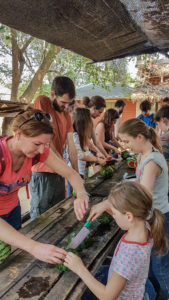 Once we received our instructions and safety information, we were to serve the elephants their breakfast. Divided into smaller groups, we were tasked with cutting up watermelon and making rice-banana-wheat balls. After all groups were finished, we hand-fed the beasts their breakfasts. The humans became very excited, some giddy, but the elephants took it in strides; they always had a hand full of food waiting for them – so why the excitement?
Once we received our instructions and safety information, we were to serve the elephants their breakfast. Divided into smaller groups, we were tasked with cutting up watermelon and making rice-banana-wheat balls. After all groups were finished, we hand-fed the beasts their breakfasts. The humans became very excited, some giddy, but the elephants took it in strides; they always had a hand full of food waiting for them – so why the excitement?- With four guides and about ten other staff for wrangling and safety measures, humans and elephants were herded in small groups and sent to the forest. We were amazed at how quietly elephants walk; only inches behind you and you may not even realize they are there – hence, the safety instructions and measures. It was also an opportune time to take selfies with them, as long as you could match their pace. The colossal beasts roamed among the trees, sometime rubbing bodies against tree trunks, some having post-breakfast snacks of grasses and foliage. As we watched, one of our guides described the history of working elephants in Thailand and the purpose of parks like these.
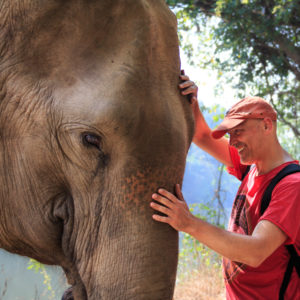 Back at camp, it was time for the humans to be fed – the lunch buffet served was not bad, actually. Some elephants came back to camp with us, some stayed out in the jungle. We spent our lunch hour chatting with a nice couple from Madrid, getting to know a bit about their own journey. We all remarked how the park elephants’ “freedom” was still controlled for the purpose of tourism – admittedly, not perfect – but far better than being forced to perform tricks or carry people on their backs.
Back at camp, it was time for the humans to be fed – the lunch buffet served was not bad, actually. Some elephants came back to camp with us, some stayed out in the jungle. We spent our lunch hour chatting with a nice couple from Madrid, getting to know a bit about their own journey. We all remarked how the park elephants’ “freedom” was still controlled for the purpose of tourism – admittedly, not perfect – but far better than being forced to perform tricks or carry people on their backs.- In the heat of midday, we walked back to jungle to watch elephants have their mud baths. At times, the spectacle was watching the elephants contend for a spot in the muddy waters or spraying their backs and undersides; other times, the buffoonery came from the visitors standing too closely to sprays of filthy water.
- Cooled by the drying mud, it was time for the elephants – and
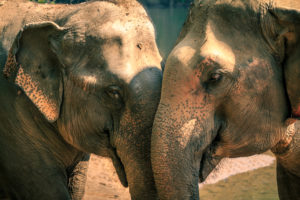 humans – to rinse down in the river. While navigating the steep slopes of the riverbank, it was best to look around and give way to anyone outweighing you by a few tonnes, even as one of the guides called out, “It’s okay!” and “Don’t worry!” He had been saying that all day, so it lost most of its effect – and all of its appeal. Humans and elephants in the water turned into a splash-fest, all focused on removing as much caked-in mud from the elephants’ back, as possible. With some play and effort, we got the job done.
humans – to rinse down in the river. While navigating the steep slopes of the riverbank, it was best to look around and give way to anyone outweighing you by a few tonnes, even as one of the guides called out, “It’s okay!” and “Don’t worry!” He had been saying that all day, so it lost most of its effect – and all of its appeal. Humans and elephants in the water turned into a splash-fest, all focused on removing as much caked-in mud from the elephants’ back, as possible. With some play and effort, we got the job done. - We returned to camp, wet and delighted from our baths. We had accomplished all our day’s chores; it was time to get into dry clothes, give a few last snacks and say goodbye to the elephants. Exhausted and thrilled, we headed back to Kanchanaburi for our last night, before leaving Thailand.
Penang, Malaysia: February 15 – 23, 2018
Time for another beach holiday! With passports in hand, we left Thailand in the direction of Penang, Malaysia, specifically the beach community of Batu Ferringhi. We mostly spent that week reading by the pool or walking along the beach – not the nicest swimming beach and there were signs warning against jellyfish. For lunches and dinners, we preferred to eat at nearby local restaurants; we returned to Helena Café many times for their yummy curries and rotis. Getting around was easy with local transit, a one-hour, direct bus ride to the historic centre of George Town. We made two excursions that week: a short trip to George Town, where we walked from Clan Jetties’ traditional waterfront stilt houses to historic Chinatown. Our second journey was to Penang Hill. After two and a half hours of public transit to get to the Lower Station, the hilltop attractions were a little disappointing. Other than the interesting steep funicular ride up and the majestic views of the island and sea, the hilltop was crowded with merchants and taxis competing for tourist dollars, and not much to offer in return.
Our poolside stay went by fast; and, suddenly, it was time to say goodbye to Malaysia and hello to Indonesia.
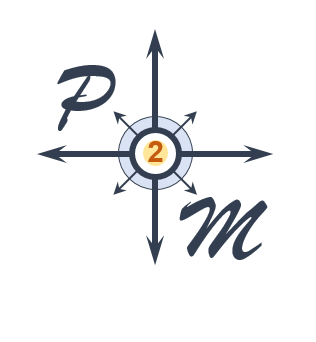
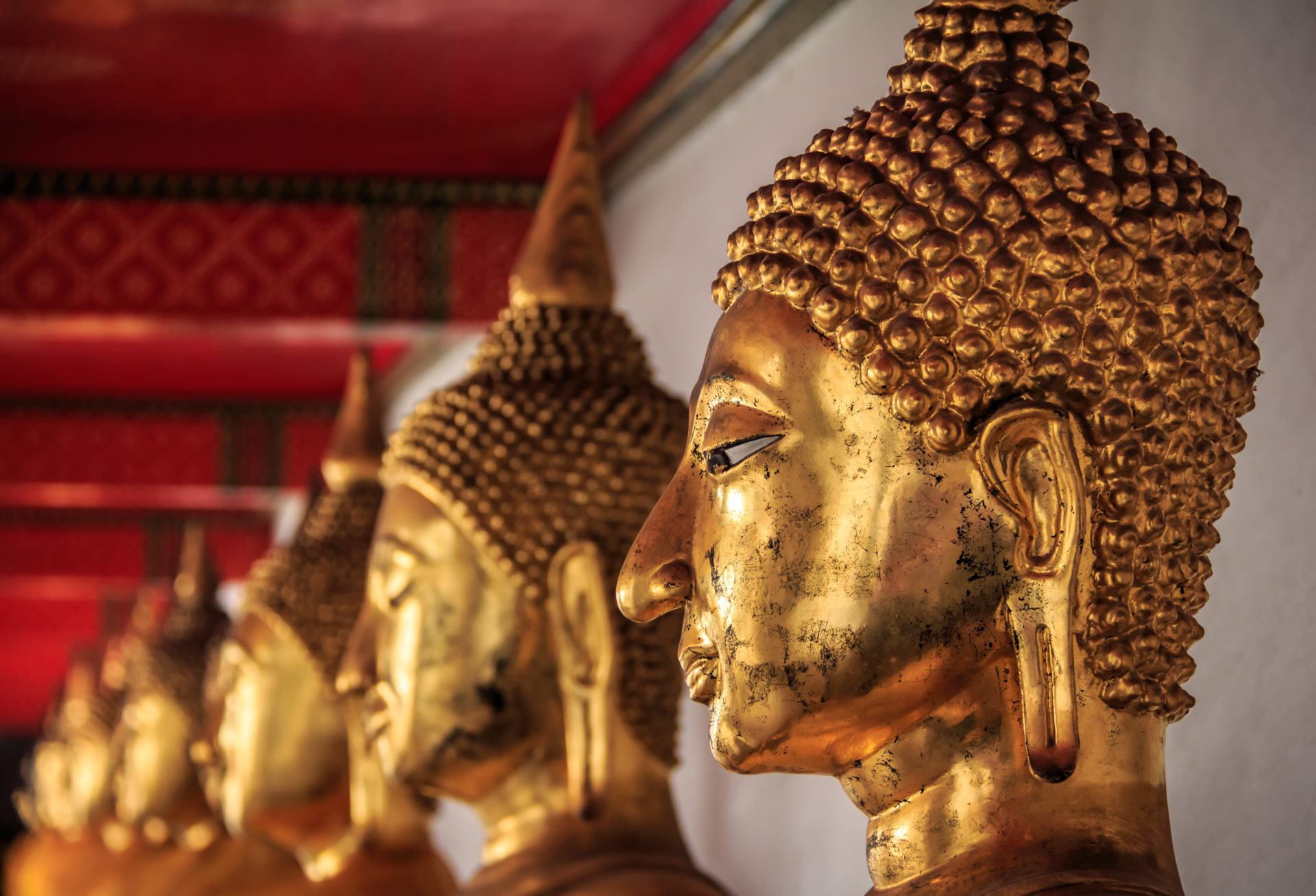
2 thoughts on “Bangkok and Kanchanaburi, Thailand February 7 – 15, 2018”
Merci cher cousin and Dave for sharing your adventures! love seeing the world thru your eyes!!
Remember: If you accidentally use salt instead of sugar, that is NOT dessert; that is chaos!
Comments are closed.